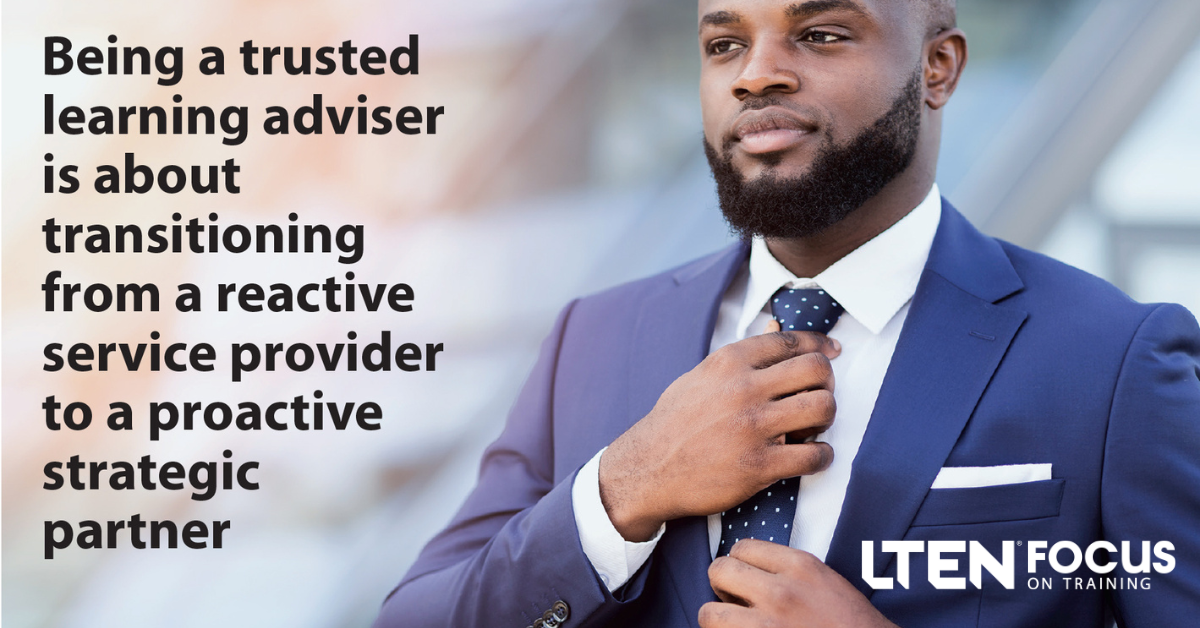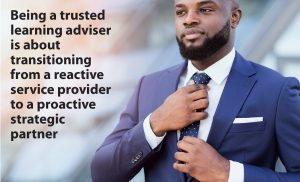
 LEARNING & LEADERSHIP – By Kristy Callahan
LEARNING & LEADERSHIP – By Kristy Callahan
Meet the role that’s redefining training’s contribution
As an executive leading a learning and leadership development team, I recently came across a book that provoked thought, The Trusted Learning Advisor by Keith Keating, Ed.D.
This book is not just a collection of insights; it’s a catalyst for deep reflection and a call to action for practitioners like us. It challenges us to ponder the evolving
essence of our profession. It invites us to step beyond the traditional boundaries and embrace a role that is dynamic, influential and deeply integrated with the
strategic goals of our organizations.
So what does it mean to be a trusted learning adviser? And how does this role redefine our contribution to the business world?
Learning Executive Series
Are you a learning leader in your organization? Interested in participating in this year’s executive-level events?
Check out the Learning Executive Series website for more information on invitation-only access to events and resources for learning leaders. Find out more information at https://www.l-ten.org/lead/.
Beyond Instruction: The Strategic Role
At its core, being a trusted learning adviser is about strategic alignment and going beyond traditional roles.
It transcends the boundaries of mere training delivery or instructional design. It also forges authentic partnerships with stakeholders, understanding their challenges and goals, and developing learning solutions that drive real business impact.
The role is also about transitioning from a reactive service provider to a proactive, strategic partner. That transformation demands a deep understanding of business dynamics, the ability to interpret and leverage data, and the skill to articulate the value of learning and development (L&D) initiatives in terms that resonate with stakeholders.
Pathway to Transformation
How do we achieve this paradigm shift? Our evolution begins with introspection.
We need to identify and confront the internal barriers that limit our progress –whether they’re outdated mindsets, a reluctance to embrace change or a lack of self-confidence in our capabilities. By acknowledging and addressing these barriers, we pave the way for personal and professional growth.
Moreover, instead of passively waiting for a seat at someone else’s table, we must take proactive steps to build our own table and invite stakeholders to sit with us.
This concept resonates deeply with design thinking principles, which emphasize a human centered approach to problem-solving. By fostering a culture of innovation and collaboration, we empower ourselves to drive meaningful change within our organizations.
Leveraging Sales Backgrounds
Drawing from our backgrounds in sales, we possess foundational skills that can be leveraged in building relationships, understanding client needs and communicating value effectively.
Like pitching a product to a healthcare provider, we must align our initiatives with the strategic goals of the organization and communicate this alignment effectively. This approach helps build trust and credibility with stakeholders, positioning us not just as L&D professionals but as strategic partners contributing to the organization’s success.
Navigating Organizational Dynamics
While aiming for ideal strategies, we often encounter the complex realities of organizational dynamics. Sometimes, this means delivering on requests that don’t perfectly align with our vision. These compromises, however, are not setbacks; they’re opportunities to build trust, demonstrate our capabilities and gain credibility.
Each project, whether fully aligned with our vision or not, is a step toward establishing ourselves as trusted learning advisers. It’s about finding the balance between adhering to our strategic vision and being adaptable to the immediate needs of the business.
The pinnacle of being a trusted learning adviser is influencing organizational strategy. Armed with data and insights, we can advocate for learning solutions that drive business results.
This influence is a testament to our journey, showcasing our ability to link learning and development initiatives to business outcomes and being a key player indecision-making processes. It empowers us to contribute significantly to the organization’s strategic direction, fulfilling our role as architects of the L&D field
Conclusion: A Call to Action
The journey to becoming a trusted learning adviser is rich and multidimensional, involving self-reflection, strategic thinking, agility and proactive engagement. It’s about leveraging our unique strengths and experiences to transcend conventional roles and emerge as transformative leaders in the L&D field.
Together, let’s embark on this journey of growth and impact, shaping the future of organizational learning one partnership at a time.
 Kristy Callahan is a learning leader executive, USCAN, for GE Healthcare. Email Kristy at kristy.callahan@ge.com or connect through linkedin.com/in/kristy-callahan-81ba29a.
Kristy Callahan is a learning leader executive, USCAN, for GE Healthcare. Email Kristy at kristy.callahan@ge.com or connect through linkedin.com/in/kristy-callahan-81ba29a.









